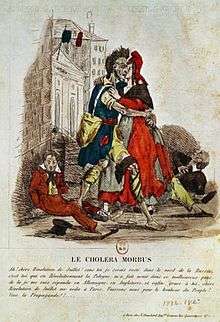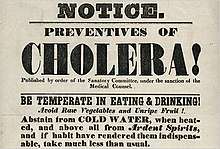1826–1837 cholera pandemic
The second cholera pandemic (1826–1837), also known as the Asiatic cholera pandemic, was a cholera pandemic that reached from India across western Asia to Europe, Great Britain, and the Americas, as well as east to China and Japan.[1] Cholera caused more deaths, more quickly, than any other epidemic disease in the 19th century. The medical community now believes cholera to be exclusively a human disease, spread through many means of travel during the time, and transmitted through warm fecal-contaminated river waters and contaminated foods. During the second pandemic, the scientific community varied in its beliefs about the causes of cholera.
| Second cholera pandemic | |
|---|---|
| Disease | Cholera |
| Bacteria strain | Vibrio cholerae |
| Location | Asia, Europe, the Americas |
| First outbreak | Ganges Delta, British India |
| Dates | 1826–1837 |
| Confirmed cases | Unknown; 250,000 in Russia |
Deaths | Unknown; 100,000 in Russia; 100,000 in France; 6,536 in London |

History
First pandemic
The first cholera pandemic (1817–24) began near Calcutta and spread throughout Southeast Asia to the Middle East, eastern Africa, and the Mediterranean coast. While cholera had spread across India many times previously, this outbreak went further; it reached as far as China and the Mediterranean Sea before receding. Hundreds of thousands of people died as a result of this pandemic, including many British soldiers, which attracted European attention. This was the first of several cholera pandemics to sweep through Asia and Europe during the 19th and 20th centuries. This first pandemic spread over an unprecedented range of territory, affecting almost every country in Asia.
Origins of the second pandemic
Historians believe that the first pandemic had lingered in Indonesia and the Philippines in 1830.
Although not much is known about the journey of the cholera pandemic in east India, many believe that this pandemic began, like the first, with outbreaks along the Ganges Delta in India. From there, the disease spread along trade routes to cover most of India. By 1828, the disease had traveled to China. Cholera was also reported in China in 1826 and 1835, and in Japan in 1831. In 1829, Iran was apparently infected with cholera from Afghanistan.
Cholera reached the southern tips of the Ural Mountains in 1829. On 26 August 1829, the first cholera case was recorded in Orenburg with reports of outbreaks in Bugulma (7 November), Buguruslan (5 December), Menselinsk (2 January 1830), and Belebeevsk (6 January). With 3500 cases including 865 fatal ones in Orenburg province, the epidemic stopped by February 1830.[2]
1830s
The second cholera pandemic spread from Russia to the rest of Europe, claiming hundreds of thousands of lives. [3] It spread during the Moscow invasion in August 1830. By 1831, the epidemic had infiltrated Russia's main cities and towns. Russian soldiers brought the disease to Poland in February 1831. A reported 250,000 cases of cholera and 100,000 deaths happened in Russia.
The cholera epidemic struck Warsaw during the Polish–Russian War 1830–31 between 16 May and 20 August 1831; 4,734 people fell ill and 2,524 died.[4] The epidemic of cholera brought to Poland and East Prussia by Russian soldiers forced Prussian authorities to close their borders to Russian transports.[5] "Cholera riots" occurred in Russia, caused by the anticholera measures undertaken by the tsarist government.
By early 1831, frequent reports of the spread of the pandemic in Russia prompted the British government to issue quarantine orders for ships sailing from Russia to British ports.[6] By late summer, with the disease appearing more likely to spread to Britain, its board of health, in accordance with the prevailing miasma theory, issued orders recommending as a preventive the burning of "decayed articles, such as rags, cordage, papers, old clothes, hangings...filth of every description removed, clothing and furniture should be submitted to copious effusions of water, and boiled in a strong ley (lye); drains and privies thoroughly cleansed by streams of water and chloride of lime...free and continued admission of fresh air to all parts of the house and furniture should be enjoined for at least a week".[7]
Based on the reports of two English doctors who had observed the epidemic in St. Petersburg, the board of health published a detailed description of the disease's symptoms and onset:
Giddiness, sick stomach, nervous agitation, intermittent, slow, or small pulse, cramps beginning at the tops of the fingers and toes, and rapidly approaching the trunk, give the first warning. Vomiting or purging, or both these evacuations of a liquid like rice-Water or whey, or barley-water, come on; the features become sharp and contracted, the eye sinks, the look is expressive of terror and wildness; the lips, face, neck, hands, and feet, and soon after the thighs, arms, and whole surface assume a leaden, blue, purple, black, or deep brown tint according to the complexion of the individual, varying in shade with the intensity of the attack. The fingers and toes are reduced in size, the skin and soft parts covering them are wrinkled, shrivelled and folded. The nails put on a bluish pearly white; the larger superficial veins are marked by flat lines of a deeper black; the pulse becomes either small as a thread, and scarcely vibrating, or else totally extinct. The skin is deadly cold and often damp, the tongue always moist, often white and loaded, but flabby and chilled like a piece of dead flesh. The voice is nearly gone; the respiration quick, irregular, and imperfectly performed. The patient speaks in a whisper. He struggles for breath, and often lays his hand on his heart to point out the seat of his distress. Sometimes there are rigid spasms of the legs, thighs, and loins. The secretion of urine is totally suspended; vomiting and purgings, which are far from being the most important or dangerous symptoms, and which in a very great number of cases of the disease, have not been profuse, or have been arrested by medicine early in the attack, succeed. It is evident that the most urgent and peculiar symptom of this disease is the sudden depression of the vital powers: proved by the diminished action of the heart, the coldness of the surface and extremities, and the stagnant state of the whole circulation.[8]
The epidemic reached Great Britain in December 1831, appearing in Sunderland, where it was carried by passengers on a ship from the Baltic. It also appeared in Gateshead and Newcastle. In London, the disease claimed 6,536 victims; in Paris, 20,000 died (out of a population of 650,000), with about 100,000 deaths in all of France.[9] In 1832, the epidemic reached Quebec, Ontario, and Nova Scotia, Canada; and Detroit and New York City in the United States. It reached the Pacific Coast of North America between 1832 and 1834.[1] The pandemic prompted the passage of the landmark Public Health Act and the Nuisances Removal Act in 1848 in England.
In mid-1832, 57 Irish immigrants died who had been laying a stretch of railroad called Duffy's Cut, 30 miles west of Philadelphia. They had all contracted cholera.[10]
Causes
During the second pandemic, the scientific community varied in its beliefs about the causes of cholera. In France, doctors believed cholera was associated with the poverty of certain communities or poor environment. Russians believed the disease was contagious, although doctors did not understand how it spread. The United States believed that cholera was brought by recent immigrants, specifically the Irish, and epidemiologists understand they were carrying disease from British ports. Lastly, the British thought the disease might rise from divine intervention.[11]
Legacy

Norwegian poet Henrik Wergeland wrote a stage play inspired by the pandemic, which had reached Norway. In The Indian Cholera (Den indiske Cholera, 1835), he criticized British colonialism for spreading the pandemic.
As a result of the epidemic, the medical community developed a major advance, the intravenous saline drip. It was developed from the work of Dr Thomas Latta of Leith, near Edinburgh. Latta established from blood studies that a saline drip greatly improved the condition of patients and saved many lives by preventing dehydration, but he was one of the many medical personnel who died in the epidemic.
See also
- Cholera outbreaks and pandemics
- Nashville cholera epidemic (1849–1850)
References
- "Cholera's seven pandemics". Canadian Broadcasting Corporation. December 2, 2008. Retrieved 2008-12-11.
Note: The second pandemic started in India and reached Russia by 1830, then spread into Finland and Poland. A two-year outbreak began in England in October 1831 and claimed 22,000 lives. Irish immigrants fleeing poverty and the Great Potato Famine carried the disease from Europe to North America. Soon after the immigrants' arrival in Canada in the summer of 1832, 1,220 people died in Montreal and another 1,000 across Quebec. The disease entered the U.S. by ship traffic through Detroit and New York City. Spread by ship passengers, it reached Latin America by 1833. Another outbreak across England and Wales began in 1848, killing 52,000 over two years. - Charlotte E. Henze (15 December 2010). Disease, Health Care and Government in Late Imperial Russia: Life and Death on the Volga, 1823-1914. Taylor & Francis. p. 13. ISBN 978-0-203-83397-1.
- J. N. Hays (2005). Epidemics and Pandemics: Their Impacts on Human History. Santa Barbara, California: ABC-CLIO. ISBN 978-1-85109-658-9. OCLC 606929770.
- Raymond Durand (1980). Robert Bielecki (ed.). Depesze z powstańczej Warszawy 1830–1831: raporty konsula francuskiego w Królestwie Polskim [Memoranda from Warsaw during the Uprising 1830–1831: reports of the French consul to the Kingdom of Poland]. Warsaw: Czytelnik. ISBN 978-83-07-00254-5. OCLC 7732541.
- Tomasz Strzeżek (1998). Kornelia Kompanowska (ed.). Warszawa 1831 [Warsaw 1831]. Historyczne Bitwy. Warsaw: Dom Wydawniczy Bellona. pp. 11–12. ISBN 978-83-11-08793-4.
- "No. 18807". The London Gazette. 27 May 1831. p. 1027.
- "No. 18863". The London Gazette. 21 October 1831. p. 2160.
- "No. 18863". The London Gazette. 21 October 1831. p. 2159.
- Rosenberg, Charles E. (1987). The Cholera Years: The United States in 1832, 1849, and 1866. University of Chicago Press. ISBN 0-226-72677-0.
- The Ghosts of Duffy's Cut. Praeger Publishers. 2006. ISBN 0-275-98727-2.
In the summer of 1832, Irish immigrant Philip Duffy contracted 57 of his newly arrived countrymen to lay a stretch of railroad some 30 miles west of Philadelphia. Within two months, all were dead, struck down in the global cholera pandemic that hit Philadelphia the same time they did.
- Hayes, J.N. (2005). Epidemics and Pandemics: Their Impacts on Human History. Santa Barbara, CA: ABC-CLIO. pp. 214–219.
